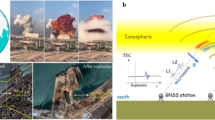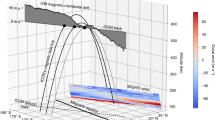Abstract
MEASUREMENTS of the horizontal velocity of travelling disturbances in the F2 region of the ionosphere have been made in this department over the past three years, using the method described by Munro1. Constant-frequency pulse transmitters were set up at the base station in the Physics Department of the University of Western Australia, and at two other stations situated respectively 15 miles east and 25 miles south-east. The two remote stations were triggered, after a short adjustable delay, by the ground wave from the University transmitter. Three sets of echoes were obtained at the base station, one reflected vertically from overhead and the other two at oblique incidence from the mid-points between the remote stations and the base. They were recorded on the one film by the conventional techniques. The frequency used was 5.8 Mc./s. and the pulses were 100 µsec. long with a pulse repetition frequency of 40 c.p.s.
This is a preview of subscription content, access via your institution
Access options
Subscribe to this journal
Receive 51 print issues and online access
$199.00 per year
only $3.90 per issue
Buy this article
- Purchase on Springer Link
- Instant access to full article PDF
Prices may be subject to local taxes which are calculated during checkout
Similar content being viewed by others
References
Munro, G. H., Proc. Roy. Soc., A, 202, 208 (1950).
Munro, G. H. (private communication).
Author information
Authors and Affiliations
Rights and permissions
About this article
Cite this article
PRICE, R. Travelling Disturbances in the Ionosphere. Nature 172, 115–116 (1953). https://doi.org/10.1038/172115b0
Issue Date:
DOI: https://doi.org/10.1038/172115b0
Comments
By submitting a comment you agree to abide by our Terms and Community Guidelines. If you find something abusive or that does not comply with our terms or guidelines please flag it as inappropriate.



